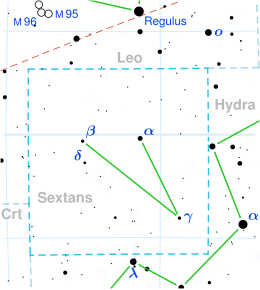| Observation data Epoch J2000.0 Equinox J2000.0 (ICRS) | |
|---|---|
| Constellation | Sextans |
| Right ascension | 10h 12m 48.36462s[1] |
| Declination | +04° 36′ 52.8378″[1] |
| Apparent magnitude (V) | 5.78±0.01[2] |
| Characteristics | |
| Evolutionary stage | red giant branch[3] |
| Spectral type | K1 III[4] or K0 III[5] |
| U−B color index | +1.11[6] |
| B−V color index | +1.18[6] |
| Astrometry | |
| Radial velocity (Rv) | 31.80±0.21[7] km/s |
| Proper motion (μ) | RA: −50.538 mas/yr[1] Dec.: −6.118 mas/yr[1] |
| Parallax (π) | 6.3184 ± 0.0625 mas[1] |
| Distance | 516 ± 5 ly (158 ± 2 pc) |
| Details | |
| Mass | 0.88+0.08 −0.03[3] M☉ |
| Radius | 23.13±1.17[8] R☉ |
| Luminosity | 241+4 −5[1] L☉ |
| Temperature | 4,576±123[9] K |
| Metallicity [Fe/H] | −0.53[10] dex |
| Rotational velocity (v sin i) | 2.5±0.8[4] km/s |
| Age | 7.94+1.83 −0.70[3] Gyr |
| Other designations | |
| Database references | |
| SIMBAD | data |
19 Sextantis (HD 88547; HR 4004; 34 G. Sextantis), or simply 19 Sex, is a solitary star[13] located in the equatorial constellation Sextans. It is faintly visible to the naked eye as an orange-hued point of light with an apparent magnitude of 5.78.[2] Gaia DR3 parallax measurements imply a distance of 516 light-years[1] and it is currently receding with a heliocentric radial velocity of 31.8 km/s.[7] At its current distance, 19 Sex's brightness is diminished by an interstellar extinction of 0.17 magnitudes.[14]
19 Sex has a stellar classification of K1 III,[4] indicating that it is an evolved K-type giant star that has ceased hydrogen fusion at it core and it has left the main sequence. It has also been given a slightly hotter class of K0 III.[5] Stellar evolution models from Stock et al. (2018) model it to be a red giant branch star (100% chance)[3] that is currently fusing a hydrogen shell around an inert helium core. It has 88% the mass of the Sun but at the age of 7.94 billion years,[3] it has expanded to 23.13 times the radius of the Sun.[8] It radiates 241 times the luminosity of the Sun[1] from its photosphere at an effective temperature of 4,576 K.[9] 19 Sex is metal deficient with an iron abundance of [Fe/H] = −0.53 or 29.5% of the Sun's[10] and it spins modestly with a projected rotational velocity of 2.5 km/s.[4]
- ^ a b c d e f g Cite error: The named reference
GaiaDR3was invoked but never defined (see the help page). - ^ a b Cite error: The named reference
Tycho2000was invoked but never defined (see the help page). - ^ a b c d e Cite error: The named reference
Stock2018was invoked but never defined (see the help page). - ^ a b c d Cite error: The named reference
Henry2000was invoked but never defined (see the help page). - ^ a b Cite error: The named reference
Adams1935was invoked but never defined (see the help page). - ^ a b Cite error: The named reference
Johnson1966was invoked but never defined (see the help page). - ^ a b Cite error: The named reference
Famaey2005was invoked but never defined (see the help page). - ^ a b Cite error: The named reference
Kervella2004was invoked but never defined (see the help page). - ^ a b Cite error: The named reference
Stassun2019was invoked but never defined (see the help page). - ^ a b Cite error: The named reference
Hekker2007was invoked but never defined (see the help page). - ^ Cite error: The named reference
Gould1879was invoked but never defined (see the help page). - ^ Cite error: The named reference
SIMBADwas invoked but never defined (see the help page). - ^ Cite error: The named reference
Eggleton2008was invoked but never defined (see the help page). - ^ Cite error: The named reference
Gontcharov2017was invoked but never defined (see the help page).
